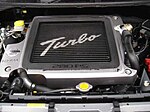- 分享
- 0
- 人气
- 0
- 主题
- 5
- 帖子
- 4372
- UID
- 227440
- 积分
- 4508
- 阅读权限
- 22
- 注册时间
- 2009-5-15
- 最后登录
- 2014-7-1
- 在线时间
- 5992 小时
  
|
SUBARU (AVCS)
 |  | 
A balance between increasing engine performance, improving fuel economy, reducing emissions and stabilizing idle is difficult to achieve. In its 3.0-liter 6-cylinder and turbocharged 2.5-liter 4-cylinder engines, Subaru strikes that balance using the Active Valve Control System (AVCS).
What AVCS Does and Its Effects
 |  |  |  |  |  |  |  | Pulling the connecting rod, the crankshaft pulls the piston toward the center of the engine, drawing in air and fuel from the intake system. The air and fuel enters the cylinder through the intake ports opened by the intake valves. This is like a person taking a breath – inhaling. AVCS adjusts exactly when intake valves begin to open. |  |  |  |  |  |  | With both valves closed, the turning crankshaft forces up the piston, compressing the air/fuel mixture. |  |  |  |  |  |  | The spark plug ignites this compressed mixture, causing an explosion that forces down the piston and connecting rod, which, in turn, rotates the crankshaft. These explosions within the cylinders provide the engine’s power. |  |  |  |  |  |  | The crankshaft forces the piston to the top of the cylinder again, this time pushing leftover gases out of the combustion chamber past the opened exhaust valves and into the exhaust system. This is similar to a person exhaling. |
The camshaft is a very precise engine component, with lobes that open and close the intake and exhaust valves with the critical timing required for the 4-stroke cycle. AVCS changes the timing of the intake valves by adjusting the positions of the camshafts based on inputs from various sensors in the powertrain. The system varies when the camshaft lobes open and close the intake valves during the 4-stroke cycle.
The effects of variable valve control include greater power through a wider range of engine speeds, improved fuel economy and reduced emissions. But to better understand how it works, let’s start with engine basics – the 4-stroke engine cycle.
The 4-Stroke Cycle
Most of today’s automotive gasoline engines function via a 4-stroke cycle. Engine components continuously cycle through four strokes, named for their functions of intake, compression, power and exhaust.
AVCS affects the roles of the camshafts in this process. Actuation is mechanical, by direct contact or through a combination of lifters, tappets and/or pushrods, depending on engine design. How the camshafts are designed essentially gives engines their personalities.
Camshafts in Subaru engines are belt-driven (4-cylinder) or chain-driven (6-cylinder) by the crankshaft. Intake valves open to let the air into the combustion chamber, and exhaust valves open to let out the exhaust gases. AVCS operation affects the intake valve timing or at exactly what point each valve opens and closes.
Overall, intake- and exhaust-valve operation during the 4-stroke cycle follows this pattern:

However, there are nuances in operation, and that’s where AVCS plays a part.
In the 4-stroke sequence, the exhaust cycle immediately precedes the intake cycle. Overlapping the timing of the closing of the exhaust valves and the opening of the intake valves can help the engine perform better under heavy loads, but not under light loads. AVCS continuously varies this overlap through an infinite number of positions. Overlap ranges between a slight overlap (“retard” position) through as much as 35 degrees of the crankshaft rotation (“advance” position).
AVCS Components
Variable valve timing is controlled through a hydraulic system that takes instruction from a system of electronic controls.
Engine management computer: Electronic control is by the engine management computer, which uses input from a number of engine sensors to determine the ideal position for the camshafts. The sensors include those that measure airflow into the intake system, coolant temperature, throttle position and camshaft position.
Oil control valve: The control unit then actuates changes through an oil control valve positioned at each intake camshaft sprocket. The oil control valve uses oil pressure from the engine to advance and retard the intake camshafts via the AVCS actuator.
Actuator: Mounted in the chain- or belt-driven drive sprocket, the actuator is fitted directly to the camshaft. Chambers in the actuator allow oil pressure to advance or retard it within the timing-belt sprocket. The oil fills the chambers and pushes against three lobes to turn the actuator and the camshaft on its axis.
AVCS – Bringing It All Together
At idle: The intake valves open just after the piston reaches the top of the cylinder (called “top dead center” or TDC; BDC refers to “bottom dead center”) at the end of the exhaust stroke, as the piston begins the intake stroke. The exhaust stroke creates negative pressure within the chamber, and intake air enters the cylinder with positive pressure “to fill the void.” There is very little or no overlap between the exhaust and the intake strokes.

Retarding valve timing improves the smoothness of engine operation at idle, which tends to be a problem area in high-performance engines without variable valve control. (If you remember the muscle cars of the 1960s and 1970s, you may recall how roughly they idled.) |
[ 本帖最后由 3-SGTE 于 2009-7-12 12:57 AM 编辑 ] |
|







 IP卡
IP卡 狗仔卡
狗仔卡
 发表于 2009-7-7 10:19 AM
发表于 2009-7-7 10:19 AM
 显身卡
显身卡
















